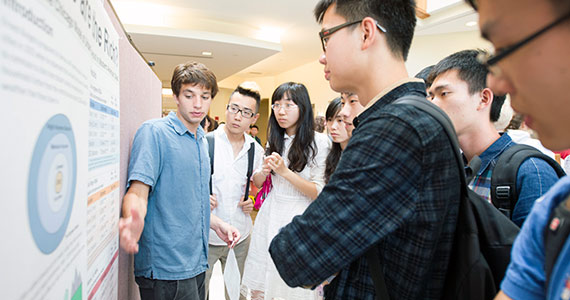
Chris Esposito ÔÇÖ14 (left) describes his research during a poster presentation at the Ho Science Center. (Photo by Andy Daddio)
51Ěš┴¸ students are sharing their experiences conducting research with faculty members on campus and in the field. This post is by economics and geography double major Chris Esposito ÔÇÖ14, of Santa Cruz, Calif..
I remember a striking quotation from Paul Krugman, the Nobel laureate and New York Times columnist. Usually academics write carefully and with narrow focus, but Krugman was blunt and far-reaching: ÔÇťOld ideas are viewed as boring, even if few people have heard of them; new ideas, even if they are probably wrong and not terribly important, are far more attractive.ÔÇŁ
I can see KrugmanÔÇÖs words in the research that I have been conducting this summer. I have been working with from 51Ěš┴¸ÔÇÖs , and the old, ÔÇťboringÔÇŁ idea in our research is the Chicago model of urban form.
The Chicago model, which originated in 1925, observed that wealthy people opt to live as close to environmental amenities as possible, placing wealth in cities away from the city center, off major roads, up the hills, and along the waterfront.
But later a new idea of the spatial layout of American cities emerged, and it attracted widespread interest, even though it is probably wrong and probably not terribly important. The new self-named Los Angeles School of Urbanism is essentially postmodern and disapproves of any systematic approach to studying cities.
The L.A. School dismisses the Chicago model as being ÔÇťout of date.ÔÇŁ But the schoolÔÇÖs postmodern foundations and rejection of the scientific process prohibit it from being supported empirically, and as such, the school rests strictly on assertion and not evidence. The L.A. School nonetheless has captured the attention of the urban geography literature.
Professor Meyer and I think that academic theories, including those of the L.A. School, should be supported by data, and so we have spent the last two months at 51Ěš┴¸ testing the schoolÔÇÖs hypothesis.
I developed my quantitative research skills in two classes at 51Ěš┴¸: Geographic Information Systems and Applied Econometrics. I added to my skills through reading and working with other faculty at 51Ěš┴¸, because spatial regression requires techniques that are not usually covered in undergraduate econometric courses.
We now have results from our study, and they suggest that the L.A. School is wrong and that the Chicago model describes the spatial patterns of American cities with striking precision. Ours is the most robust quantitative examination of the Chicago model since the 1970s, and we plan to submit our findings for publication soon.
Has my research experience been exciting? Most certainly.
It also is intimidating; we hope to shift the direction of the literature, and soon academic peer reviewers that have studied cities and statistics for decades will scrutinize my statistical regression to determine its merit. It feels as though I am stepping into a big-league batterÔÇÖs box for the first time. But Professor Meyer and I are confident in our results. Plus, I hope to do related work in the future, in graduate school and later in my professional career. So my research this summer at 51Ěš┴¸ may well be my first big step in a scholarly direction.
We have reason to be optimistic; unlike the L.A. School, the data is on our side.